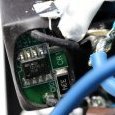You should provide more detail how they connect, does all running long cable in SATA protocol so cause error ? If that, you can fix it by make them in SAS protocol in all long path, only last mile in SATA.
With connect HBA to SAS expander, then this path will be SAS and support long distance < 10m, in each enclosure then fan-out from expander to SATA harddisk will be SATA and make them shorter then 1m.
Next was rack disk swap case, rack case have backplane, so it eliminate mass power cabling to power up all disks. But also due to backplane only have small area to passthrough air flow, so it very hard to cool well even you putting 3000rpm or high pressure fan for cooling.
I build in two box, it is a 3U expander (w mobo) case + 2U raw case (disk only), I add a expander ace-82885t in 2U enclosure and use one 8644 cable ( 50cm ) to connect them, the HBA are 9300-4i4e.
It have different generation, the first version use two 9211-8i, one for internal and one for external, the external use a pair 8087 2m cable and IBM expander for the 2U path. The second version was 9211-8i + 1000-8e .... and currently only use one 9300-4i4e.




